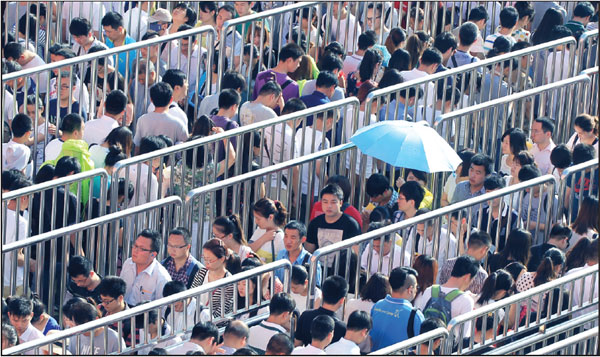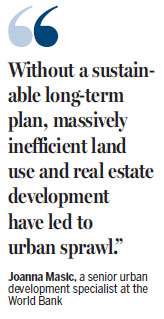Construction boom fails to clear China's crowded cities
Updated: 2016-09-23 10:12
By Wang Yanfei(China Daily)
|
|||||||||
Poor infrastructure and a lack of facilities in many new suburban townships mean the nation's downtowns remain overcrowded. Wang Yanfei reports.
Experts are calling on the government to urgently to formulate solutions to urban planning problems, as concerns rise about the lack of infrastructure construction and policy support given to new suburban districts and townships.
Although people are being encouraged to relocate from the overcrowded downtowns, a lack of schools, hospitals and transportation systems in suburban areas mean many are reluctant to move.
The inefficient transportation network in some outlying areas of Beijing has prompted widespread criticism from residents, such as Lyu Ling, who lives in the eastern suburb of Beiqijia, between the capital's Fifth and Sixth Ring Roads, about 24 kilometers from the downtown.
Lyu said she is regularly late for appointments because the network is uncoordinated, so trains and buses rarely coincide.
"I have to walk 20 minutes to the nearest bus station and then spend 15 minutes getting to the nearest subway station," she said, "I often wonder if I am still living in Beijing - the capital seems far bigger than before."
The 23-year-old cited a recent incident where despite leaving home two hours before a scheduled meeting with friends in the Haidian district, she still arrived late.
Lyu's family bought the house in 2006, and in the following decade they witnessed how Beijing's massive urban sprawl - the construction of new towns near the periphery - has resulted in a range of problems.
"The area where my community stands was barren and underdeveloped 10 years ago," she said. "We bought the house because the district was expected to be developed extensively in the future and we thought it would be a good investment."
The developer promised that the district would eventually have convenient transportation and entertainment facilities, but "the CEO of the real estate firm committed suicide a couple of years ago. I guess it was because residential property prices failed to surge as high as he expected and he couldn't repay the debt."
Real estate agent Lin Chaoxin said property prices haven't risen exorbitantly in Beiqijia compared with the "scary price surge in Beijing's core areas", a reference to the soaring prices within the Fifth Ring.
Pilot towns
In the early 1990s, the National Development and Reform Commission chose Beiqijia as one of a number of pilot towns for the capital's urban expansion plan.
In 2006, a revised municipal development plan handed the district the "key task" job of developing itself into an innovative hi-tech industrial development zone for information technology, biotechnology and high-end equipment manufacturing.
Although a number of State-owned companies moved to Beiqijia in 2009, the area still lacks basic infrastructure and remains, in Lyu's view, a "sleepy town".
Many similar small and medium-sized new towns and cities are being built across China, each with a different key task assigned by the central government.
By the end of May, 3,500 new towns and cities had been built nationwide, according to the NDRC's annual New Town and New City Development report.
The massive urban expansion is the result of the national plan to relocate 100 million rural residents to urban regions by the end of 2020, a key task in the 13th Five-Year Plan (2016-20).
Inefficient land use
The problems resulting from urban sprawl have loomed large in recent years, according to Joanna Masic, a senior urban development specialist at the World Bank.
"Without a sustainable long-term plan, urban sprawl has led to massively inefficient land use and real estate development," she said, adding that the requisition of rural land for industrial use has been particularly inefficient because it has largely been driven by administrative decisions not market demand.
Data from the Beijing Municipal Institute of City Planning and Design show that in the Beijing suburb of Yizhuang, industrial land use accounts for a large proportion of the government's urban development plan, while the development of public facilities accounts for a much smaller slice.
Meanwhile, data from the NDRC's report show that in 2006, industrial fixed-asset investment was more than 728 billion yuan ($109 billion), while residential investment was just 35.6 billion.
The year-on-year rise in the rate of industrial fixed-asset investment outstripped that of residential investment until 2012, and it is still much higher in absolute terms.
Moreover, from 2005 to 2011, the year-on-year growth rate of land used for healthcare services rose from 5.52 percent to 8.67 percent, while the rate for commercial land use rose from about 25 percent to nearly 121 percent during the same period.
"People don't want to live in areas with inconvenient access to basic public services," said Feng Kui, an NDCR researcher who led the commission's survey.
The lack of opportunities and facilities as attractive as those offered in the more-centralized districts of the capital makes people, especially the younger generation, reluctant to move to new townships and they are opting to remain in the overcrowded core areas, despite rising traffic congestion and air pollution he added.
Shen Chi, director of the planning institute at the China Center for Urban Development, an NDRC think tank, echoed Feng's view: "Young people are seldom willing to move to a distant place and give up the opportunities a metropolis can offer."
- US fighter jet crashes off coast of Okinawa, Japan: DM
- State of emergency declared in US city Charlotte amid violent protests
- Clinton to highlight foreign policy experience to woo voters
- UN chief calls for support for political solution to Syrian conflict
- Brazil to begin Zika vaccine trials in humans
- Greek govt vows to improve refugee situation on island after fire

 Li, Trudeau inaugurate 'new annual dialogue'
Li, Trudeau inaugurate 'new annual dialogue'
 Milan Fashion Week: Prada Spring/Summer 2017
Milan Fashion Week: Prada Spring/Summer 2017
 Panchen Lama prayers at foot of Qomolangma
Panchen Lama prayers at foot of Qomolangma
 Ai Fukuhara and her newlywed husband show up in Taiwan
Ai Fukuhara and her newlywed husband show up in Taiwan
 8 things you may not know about Autumn Equinox
8 things you may not know about Autumn Equinox
 Italian sets new record with Ferrari on 'miracle road'
Italian sets new record with Ferrari on 'miracle road'
 Students compete for flight attendant jobs in Sichuan
Students compete for flight attendant jobs in Sichuan
 1st Sushi restaurant opens in DPRK
1st Sushi restaurant opens in DPRK
Most Viewed
Editor's Picks

|

|

|

|

|

|
Today's Top News
Trump outlines anti-terror plan, proposing extreme vetting for immigrants
Phelps puts spotlight on cupping
US launches airstrikes against IS targets in Libya's Sirte
Ministry slams US-Korean THAAD deployment
Two police officers shot at protest in Dallas
Abe's blame game reveals his policies failing to get results
Ending wildlife trafficking must be policy priority in Asia
Effects of supply-side reform take time to be seen
US Weekly

|

|











